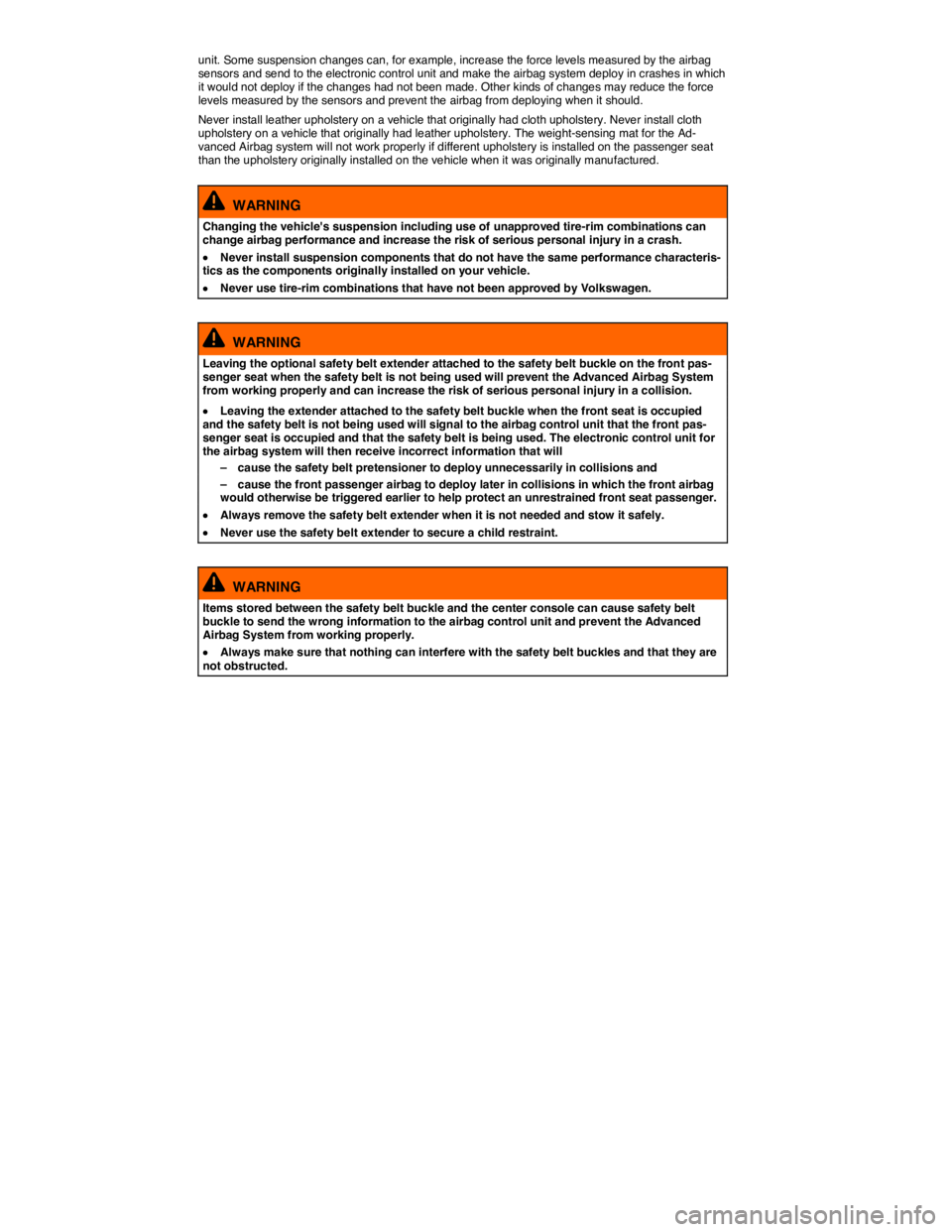2010 VOLKSWAGEN TOUAREG front seat
[x] Cancel search: front seatPage 426 of 684

Defensive driving and “flowing” with traffic
Frequent braking and acceleration increases fuel consumption significantly. Just by driving defensively and keeping a sufficiently large distance away from the vehicle in front of you can make up for the speed fluctuations caused by taking your foot off the accelerator. Active braking and accelerating is then not necessarily required.
Calm and smooth driving
Consistency is more important than speed. The more smoothly you drive, the less fuel the vehicle consumes.
When driving on the highway or freeway, a constant, moderate speed is more efficient and economical than constantly accelerating and braking. Usually you can reach your destination just as quickly by driving at a moderate, but steady speed.
The cruise control system can assist in maintaining a uniform driving style.
Moderate use of extra electrical loads
Comfort inside the vehicle is nice and important, but it is important to use them in an environmentally conscious manner.
Some devices can increase fuel consumption when activated (examples):
�x Climate control system (air conditioner): If the climate control system has to produce starkly con-trasting temperatures, it requires a large amount of energy, which is generated by the engine. The temperature in the vehicle should therefore not be extremely different from that of the outside tempera-ture. It may be helpful to ventilate the vehicle before driving and then to drive a short distance with the windows open. After that, switch on the air conditioner with the windows closed. Keep the windows closed when driving at high speeds. Open windows increase fuel consumption.
�x Switch off seat heating once it has served its purpose.
�x Switch off the windshield and rear window defroster as soon as the windows are free of fog and ice.
Additional factors that increase fuel consumption (examples):
�x Malfunctioning engine control.
�x Driving in the mountains.
�x Towing a trailer.
NOTICE
Never let the vehicle coast or roll down a hill in Neutral (N), especially when the engine is not running. The transmission will not be lubricated and will be damaged.
See additional tips on using your hybrid drive to help reduce fuel consumption.
Page 440 of 684

Driving situa-
tions
Requirements and
conditions Vehicle behavior
– Avoid speeds of over
about 160 km/h
(99 mph).
Efficient sailing is possible with
a speed of about 160 km/h
(99 mph).
– Careful selection of
gear (S).
Sporty driving style with acti-
vated sport program increases
fuel consumption. Efficient
sailing in sport program with
combustion engine automati-
cally switched off is possible
with a speed of about 70 km/h
(43 mph).
Driving in cold
months.
– Do not warm up the
combustion engine by
running it with the vehi-
cle stationary.
The temperature of the com-
bustion engine increases very
slowly, but fuel consumption
increases considerably.
– Careful use of heating
for the rear window,
outside mirror, steering
wheel and front seats.
This prevents energy from
being lost and saves energy
for the electric motor.
– Leave the vehicle in a
garage overnight.
This prevents the high-voltage
battery and the vehicle interior
from cooling down too much.
The optimal temperature of the
high-voltage battery is reached
quicker at the beginning of the
journey and the combustion
engine can be switched off
quicker when the vehicle inte-
rior is sufficiently heated.
Page 615 of 684

unit. Some suspension changes can, for example, increase the force levels measured by the airbag sensors and send to the electronic control unit and make the airbag system deploy in crashes in which it would not deploy if the changes had not been made. Other kinds of changes may reduce the force levels measured by the sensors and prevent the airbag from deploying when it should.
Never install leather upholstery on a vehicle that originally had cloth upholstery. Never install cloth upholstery on a vehicle that originally had leather upholstery. The weight-sensing mat for the Ad-vanced Airbag system will not work properly if different upholstery is installed on the passenger seat than the upholstery originally installed on the vehicle when it was originally manufactured.
WARNING
Changing the vehicle's suspension including use of unapproved tire-rim combinations can change airbag performance and increase the risk of serious personal injury in a crash.
�x Never install suspension components that do not have the same performance characteris-tics as the components originally installed on your vehicle.
�x Never use tire-rim combinations that have not been approved by Volkswagen.
WARNING
Leaving the optional safety belt extender attached to the safety belt buckle on the front pas-senger seat when the safety belt is not being used will prevent the Advanced Airbag System from working properly and can increase the risk of serious personal injury in a collision.
�x Leaving the extender attached to the safety belt buckle when the front seat is occupied and the safety belt is not being used will signal to the airbag control unit that the front pas-senger seat is occupied and that the safety belt is being used. The electronic control unit for the airbag system will then receive incorrect information that will
– cause the safety belt pretensioner to deploy unnecessarily in collisions and
– cause the front passenger airbag to deploy later in collisions in which the front airbag would otherwise be triggered earlier to help protect an unrestrained front seat passenger.
�x Always remove the safety belt extender when it is not needed and stow it safely.
�x Never use the safety belt extender to secure a child restraint.
WARNING
Items stored between the safety belt buckle and the center console can cause safety belt buckle to send the wrong information to the airbag control unit and prevent the Advanced Airbag System from working properly.
�x Always make sure that nothing can interfere with the safety belt buckles and that they are not obstructed.
Page 616 of 684

WARNING
Improper care and servicing, and improper modification and repair work, can increase the risk of personal injury and death by preventing an airbag from deploying when needed or deploying an airbag unexpectedly:
�x Never repair, adjust, or change any parts of the airbag system.
�x All work on the airbag system, steering wheel, instrument panel, front seats or electrical system (including the installation of audio equipment, cellular telephones and CB radios, etc.) should be performed by authorized Volkswagen dealers or authorized Volkswagen Ser-vice Facilities. They have the necessary manuals, training, and special equipment.
�x The airbag system can be activated only once. After an airbag has inflated, it must be replaced.
�x Use only original equipment airbags approved by Volkswagen. Have them installed by a trained technician who has the necessary tools and diagnostic equipment to properly replace any airbag in your vehicle and assure system effectiveness in a crash.
�x Never permit salvaged or recycled airbags to be installed in your vehicle.
Undeployed airbag modules and safety belts pretensioners are classified as Perchlorate Mate-rial – Special handling may apply. Obey all legal requirements regarding handling and disposal of these components – see http://www.dtsc.ca.gov/hazardouswaste/perchlorate. Obey all applicable legal requirements regarding handling and disposal of the vehicle or parts of its restraint system, including airbag modules and safety belts with pretensioners. Authorized Volkswagen dealers and authorized Volkswagen Service Facilities are familiar with the requirements, and we recommend that you have them perform this service for you.
Notice about data recorded by the Event Data Recorder and vehicle
control modules
�
Page 629 of 684

Description Possible causes
among others Possible remedy
when vehicle is
unlocked. Memory-seat settings
are stored.
– Reassign seat setting
– Clear memory-seat
memory
Front seats cannot
be adjusted with
power controls.
Vehicle battery dead. Charge vehicle battery
Fuse blown. Check fuse and replace if
necessary
No jack in vehicle
or no collapsible
spare tire or tire
mobility set in ve-
hicle.
Equipment differs
depending on vehicle.
No direct corrective action
possible because this de-
pends on the equipment.
Contact an authorized
Volkswagen dealer or an
authorized Volkswagen Ser-
vice Facility for assistance
Vehicle has mobility
tires.
Features do not
work as described
in this Manual.
Settings were
changed in the
Volkswagen Infor-
mation System or
Infotainment System.
Check and reset to factory
settings if necessary or
Headlights do not
light up the road as
they should.
– Headlights incorrect-
ly adjusted.
– Light bulbs burned
out.
– Low beams not
switched on.
– Adjust headlight range
– Change light bulbs
– Switch on low beams
Electrical appli-
ances do not work.
Vehicle battery charge
too low. Charge vehicle battery
Remaining fuel level
too low. Refuel
Fuse blown. Check fuse and replace if
necessary
Page 674 of 684

WARNING
Improper use of jumper cables when jump-starting a vehicle with a dead battery can cause the battery to explode, leading to serious personal injury. To help reduce the risk of battery explosion:
�x All work on the batteries or the electrical system in your vehicle can cause serious acid burns, fires, or electrical shocks. Always read and heed the following WARNINGS and safety
precautions before working on the batteries or the electrical system ⇒ 12 Volt vehicle bat-tery.
�x Always wear proper eye protection. Never lean over the vehicle batteries.
�x Attach the jumper cables in the correct order: first the positive cable, then the negative cable.
�x Never connect the negative cable from the vehicle providing starting assistance to parts of the fuel system or to the brake hoses or brake lines.
�x Never allow the non-insulated parts of the battery clamps to touch.
�x Never allow the jumper cable attached to the positive battery terminal to contact metal parts of the vehicle.
�x Specialized knowledge and tools are required to access the vehicle battery. For this rea-son, have an authorized Volkswagen dealer or an authorized Volkswagen Service Facility check the electrolyte level of the vehicle battery.
�x Avoid electrostatic discharge in the vicinity of the vehicle battery. Sparks may cause the hydrogen gas escaping from the vehicle battery to ignite.
�x Never jump-start a vehicle with a battery that is damaged or frozen or that was frozen and has thawed. The battery can explode. Replace the battery instead.
�x Always follow the instructions of the jumper cable manufacturer.
�x Always make sure that the battery providing starting assistance has the same voltage as the dead battery (12 V) and about the same capacity (see battery label).
�x Batteries give off explosive hydrogen gas. Always keep fire, sparks, open flame and smok-ing materials away from batteries.
�x Never connect the negative cable from the other vehicle directly to the negative terminal of the dead battery. The hydrogen gas from the battery is explosive.
�x Never short out the battery terminals by connecting the positive (+) and negative (–) ter-minals with each other.
NOTICE
Checking the electrolyte level
�x The 12 Volt vehicle battery is located under the left front seat. Specialized knowledge and tools are required to access the vehicle battery. For this reason, have an authorized Volkswagen dealer or an authorized Volkswagen Service Facility check the electrolyte level of the vehicle battery.